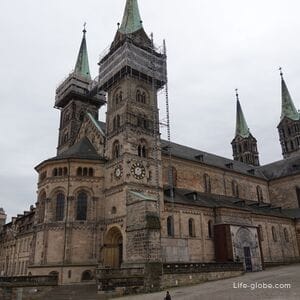Bamberg Cathedral (Bamberger Dom) - the Imperial Cathedral of Bamberg, which dates back to the 13th century, is the dominant of the historical center of the city, as well as an example of Romanesque architecture with Gothic elements.
This is the main temple of Bamberg - the Cathedral, which is included in the UNESCO World Heritage List "City of Bamberg".
The official name of the cathedral: Bamberg Cathedral of St. Peter and St. George (Bamberger Dom St. Peter und St. Georg).
The cathedral was founded in 1002 by King (and later Emperor) Heinrich II (Heinrich II). The cathedral was consecrated on Henry's 39th birthday on May 2, 6, 1012.
On April 3, 1081, on Holy Saturday, the cathedral burned down. The holy bishop, Otto I, who ruled Bamberg in 1102-1139, began a new construction of the cathedral, but already in 1185 there was a fire in the cathedral again.
In 1215, under Bishop Eckhart of the dynasty of the Counts of Andex-Meran, construction began on the third and new Romanesque-style cathedral, already with four towers, and not as before, only two in the east. Larger cathedral (current) it was consecrated on May 6, 1237.
Today the cathedral is an outstanding structure of Bamberg, has 4 towers and reflects the situation that existed in the German Empire at the beginning of the 13th century - the transition from the late Romanesque style (eastern part of the cathedral) to the early Gothic (western part of the cathedral). Different styles are especially pronounced in the features of the cathedral towers.
On the north-eastern tower there is a tower clock, which was originally the first mechanical clock and was used to divide the time for prayer and the working day. This watch was the most important chronometer of the city of Bamberg until 1954. Subsequently, the watch was replaced.
The length of the Bamberg Cathedral is approximately 99 meters; the width is 28 meters, 26 meters is the height of the central nave; each of the four towers is about 81 meters in height.
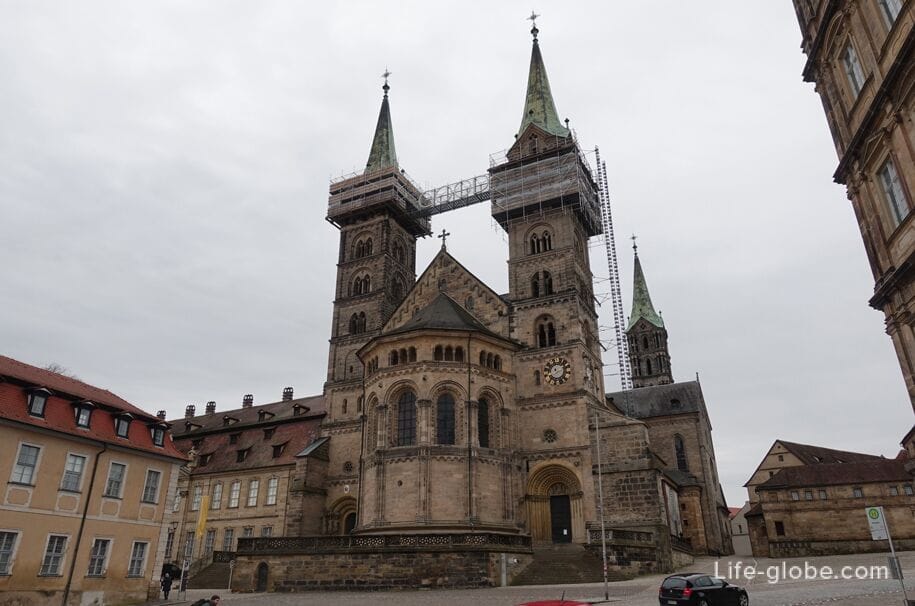
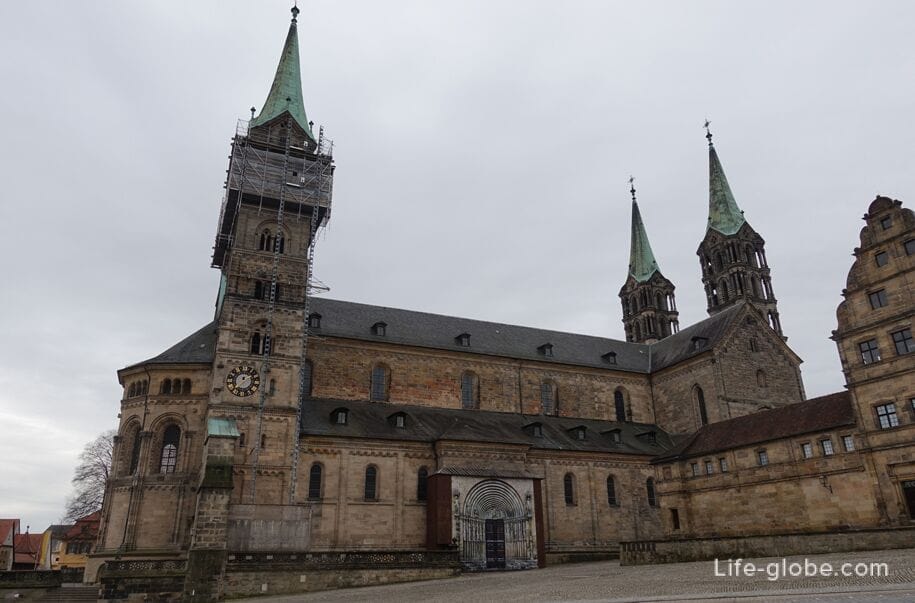
The cathedral will also be distinguished by four portals, two of which are located on the eastern side and two on the northern facade.
On the east (central) side there are the gates of Our Lady Mary and the Adam's Gate, decorated with figures of Stephen, Cunegonde, Henry, Peter, Adam and Eve (today they are copies).
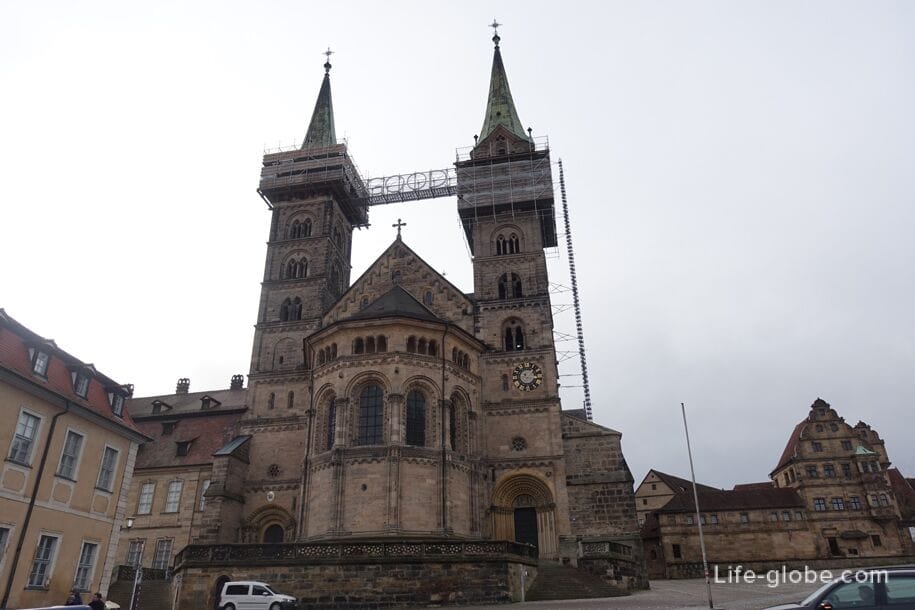
From the north (side) the parties are:
- the gate of St. Vitus (Veitspforte) is the least decorated entrance to the cathedral. The portal wall is divided into three parts; the columns are decorated with capitals in the form of cups and buds; in the lower field there is a quatrefoil with a cross;
- The Prince's Gate or Prince's Portal (Fürstenportal) is the main portal of the Bamberg Cathedral. Its location on the north side of the nave is oriented to the Cathedral Square.
In the tympanum (arched area above the portal) there is a tympanum with the image of the Last Judgment, on two walls of the funnel the prophets of the Old Testament and the apostles of the New Testament are placed on top of each other. Sculptures are located on columns in the archivolts (inside the round arch) and on both sides of the portal.
These gates are opened only on special festive services, for example, for a procession on the feast of the Corpus Christi.
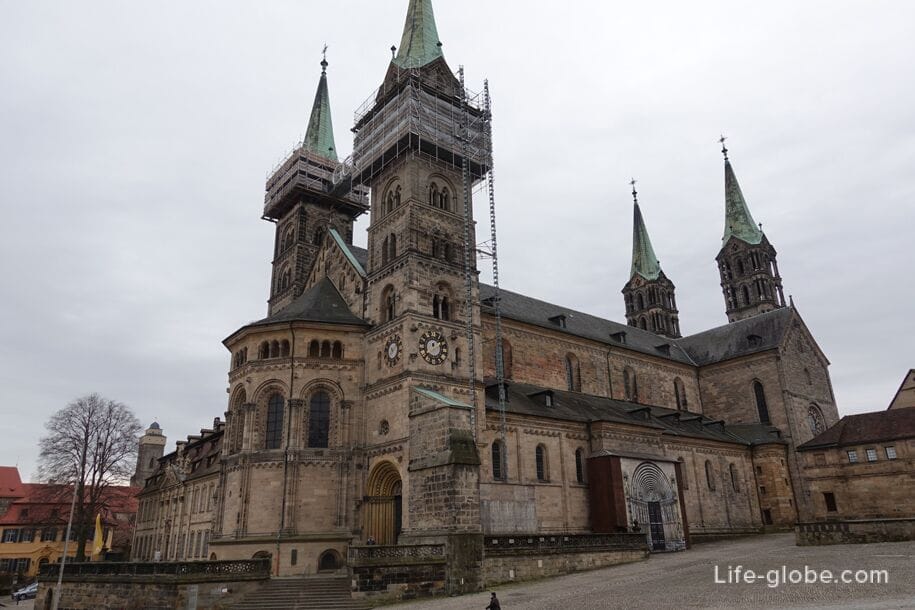
Throughout its long history, Bamberg Cathedral has been the burial place of more or less famous people. In addition to the emperor and the pope, several bishops were buried here, because each bishop had the right to be buried in his episcopal church. The Baroque tombs were removed in the 19th century and moved to the church of the former Mikhailovsky Monastery.
Interior of the Bamberg Cathedral
In the 17th century, the interior of the cathedral was decorated in the Baroque style. In 1828-1837, the Baroque decoration was lost and replaced by neo-Romanesque, which in general has survived to the present day.
During the last renovation of the cathedral, in 1969-1974, changes were made in accordance with the liturgical reform initiated by the Second Vatican Council: the main altar (throne) was moved from the eastern apse to the western one. Thus, there is a choir at each end of the cathedral.
The Eastern Choir is the oldest part of the cathedral, which is still made in the Romanesque style. The carvings of the choir depict scenes that symbolize the victory over evil, but are also made as decorative elements. Apostles and prophets are depicted on the side fences of the choir.
The fresco in the apse of the choirs, in which the all-embracing Christ opens his arms, belongs to the brush of Karl Kaspar (1927 - 1928). In the fresco above Christ, the hand of God stretches from heaven, and at his feet two deer drink water from a spring - these animals symbolically depict the souls of people thirsting for God. The winged symbols of the evangelists are depicted on the sides of Jesus, and on the edges the patron saints of the cathedral - Peter with keys and a model of the cathedral in his hands and George the Victorious in full armor with a spear and shield. A Latin inscription stretches below: "I am alpha and omega, the beginning and the end - who is and who was and who is coming - the almighty."
The eastern altar, elevated due to the presence of a crypt under it, is dedicated to St. George.
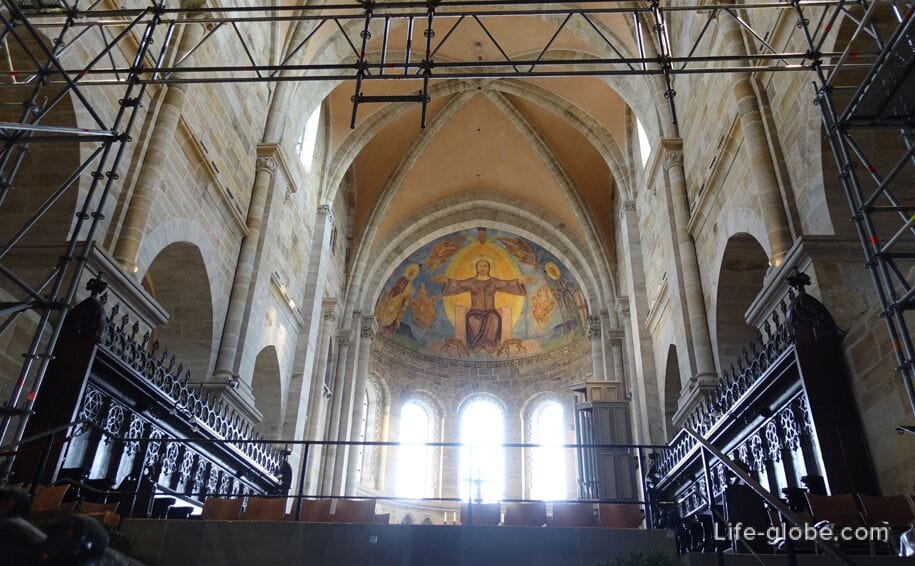
Under the eastern apse there is a crypt (Eastern Crypt), which is a three-nave hall. This is the oldest part of today's cathedral.
The crypt contains tombs that were moved to it in the 19th and 20th centuries from the eastern choirs and the central nave. On the southern wall near the font in a neo-Roman sarcophagus rest the remains of the Bamberg bishops of the 11th and 12th centuries, as well as the remains of King Conrad III, who died in Bamberg in 1152. At the altar level are the tombs of Bishops Gunther and Otto II.
The font in the crypt is still used for baptisms today.


The Western Choir, dedicated to Saint Peter, has great liturgical significance because it is the liturgical center of the cathedral with an altar common to the bishop, the cathedral chapter and the cathedral parish.
There is also a bishop's pulpit and the tomb of Pope Clement II (1046-1047), who ruled as the second bishop of Bamberg as Sweitger I (1040-1046). The large chandelier suspended in the vault is also impressive.
The main altar and the pulpit were created by the Munich master Klaus Bakmund (1974-1975). The base of the altar is made of sandstone, the altar board protrudes from all sides above the base and is decorated with bronze panels with images of Christ.
The crucifixion with the surrounding group (Mary Magdalene, Mary the Mother of Jesus and John) was executed in 1649 by Justus Glesker from gilded linden in the Baroque spirit. The crucifix was sold after 1835, when the cathedral was freed from Baroque elements, and was bought back in 1912 and installed in the western choirs in 1937.
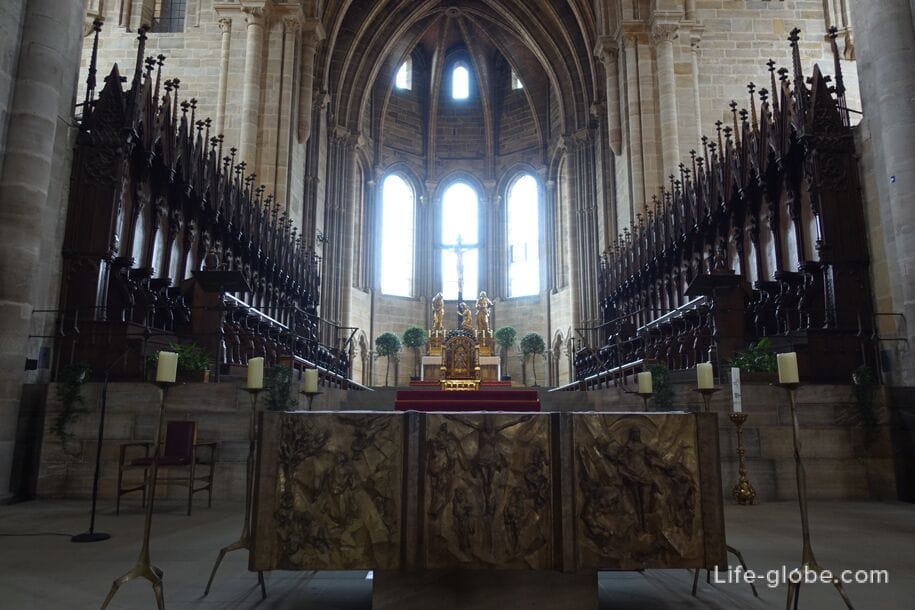
The Western crypt (crypt) was originally created with the first cathedral. It was rediscovered in the 20th century - excavations were carried out in 1987-1995.
There is a well-preserved northern and eastern part of the crypt, which includes a complete northern exterior wall with five original arched windows and former entrances to the crypt from the north and southeast.
It houses a statue of St. Otto by Fritz Koenig. In the west there is a simple altar block.
The tombs of the bishops were made according to the plan of the architects Alexander von Brank and the sculptor Fritz Koenig. In 1996 they were consecrated. Archbishop Joseph Schneider (1955-1976) was the first to rest here.
The chapel of the Imperial Heads was arranged here to store the remains of the founders of the diocese - St. Henry and St. Cunegonde. The chapters rest in a glass coffin.
The passage to the tombs of the bishops and the chapel of the heads is located in the right side aisle of the cathedral.
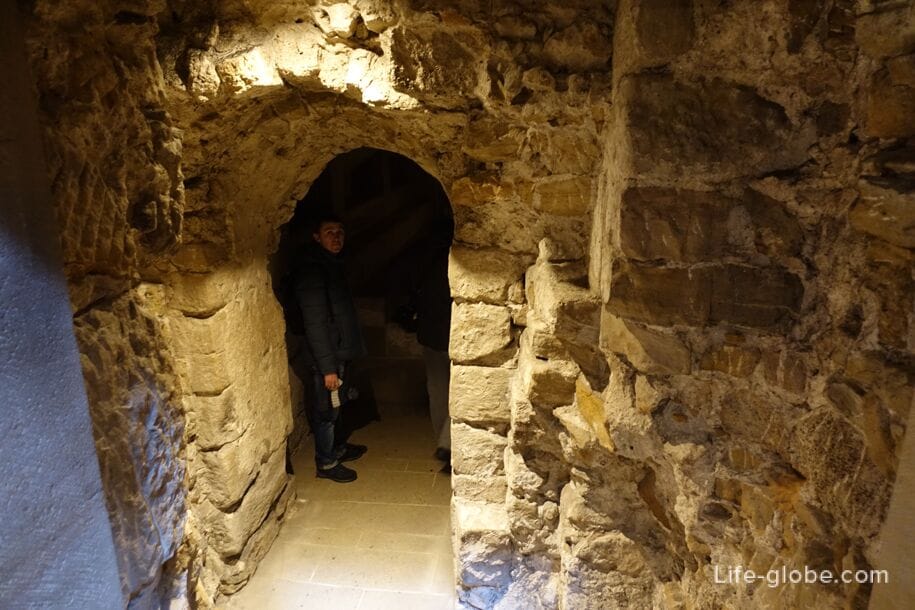
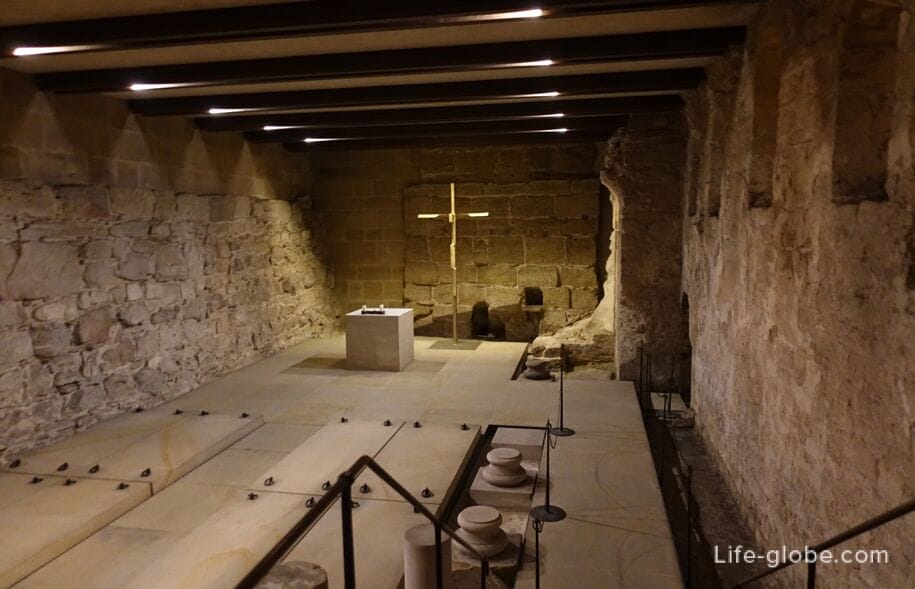
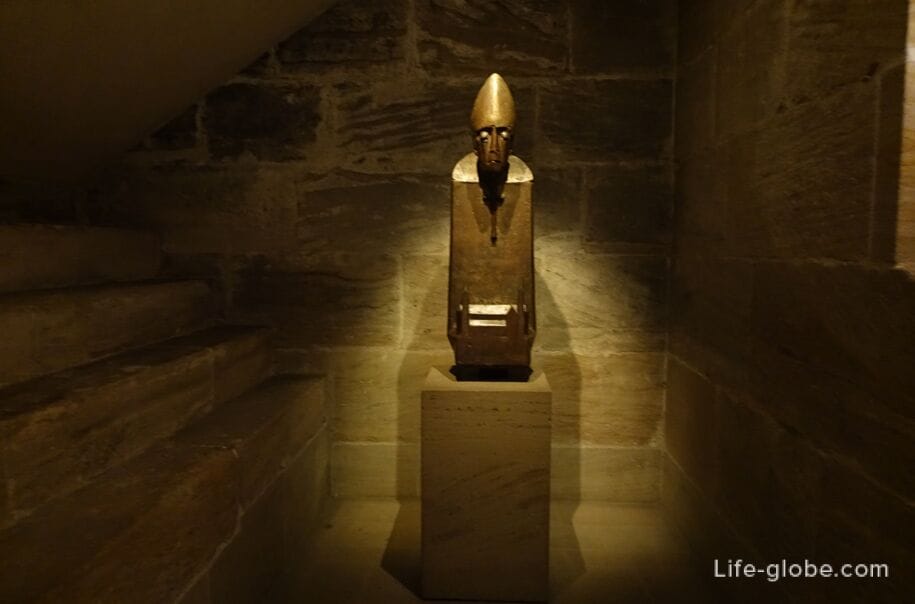
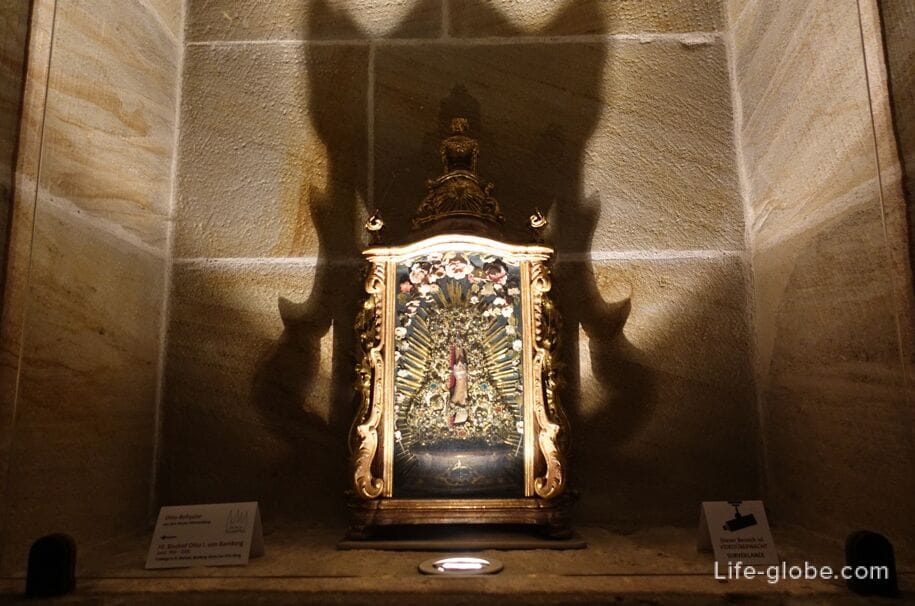
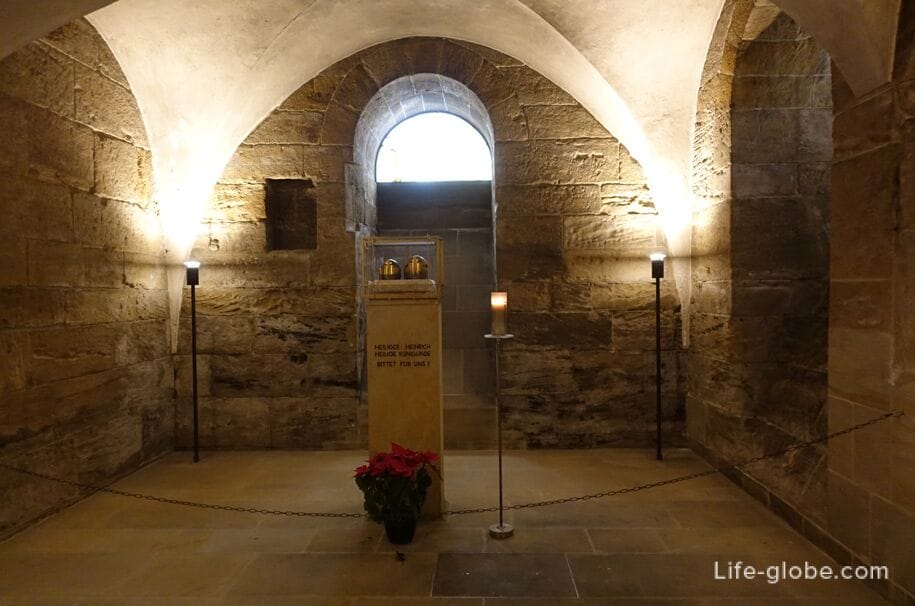
The central nave of the cathedral connects the eastern and western choirs and is about a third of the total length of the church. There are side aisles on both sides of the nave.

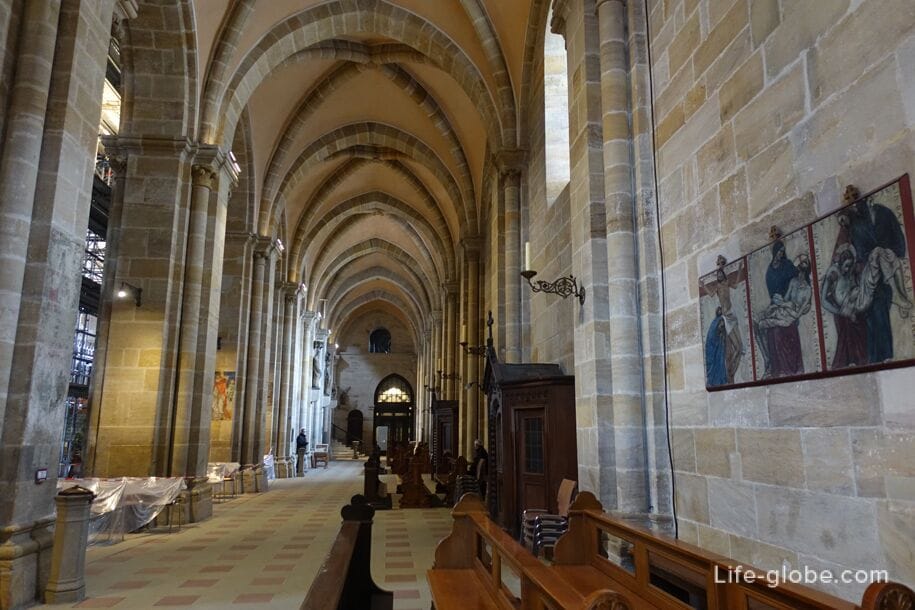
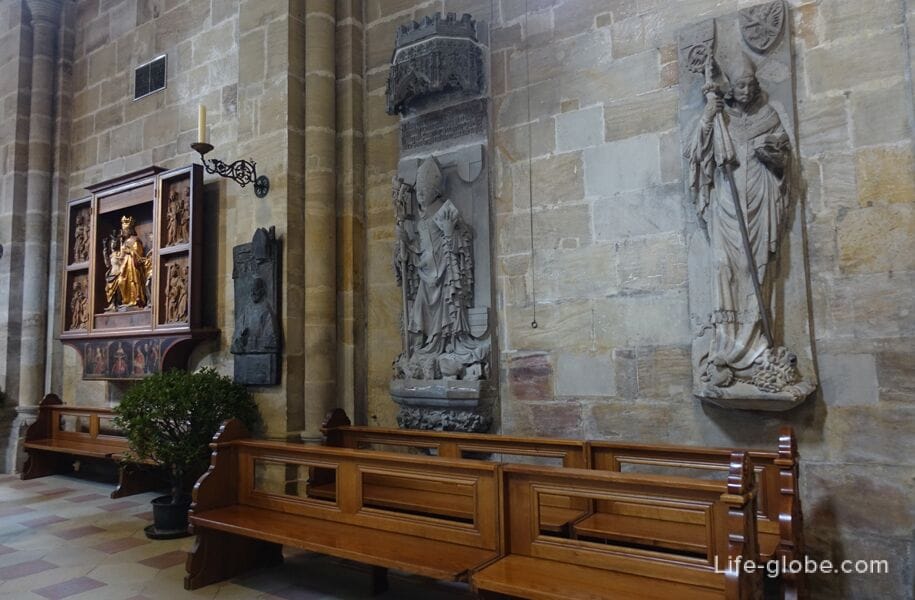
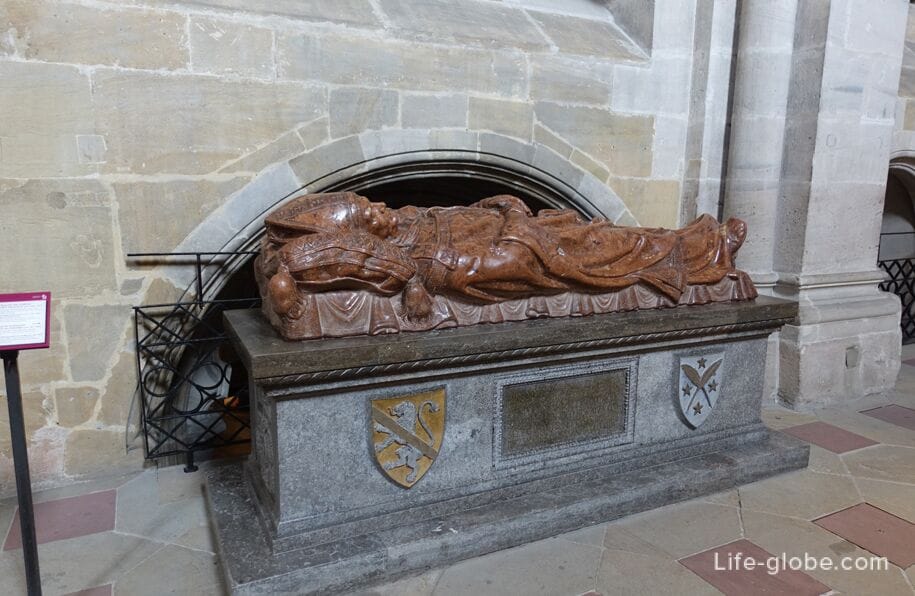
In this part of the cathedral stand out:
- the tomb of the holy imperial couple - Henry II and his wife, the Holy Empress Cunegonde. The tomb is a place of memory and worship, attracting the attention of pilgrims and admirers for centuries.
The holy couple is depicted on the cover of the sarcophagus, and on the sides there are 5 reliefs, scenes from the life of both rulers;

-the pulpit, built in 1835 and 1836 and furnished in neo-Romanesque style. The high reliefs in the arcades depict Christ and the four Evangelists;
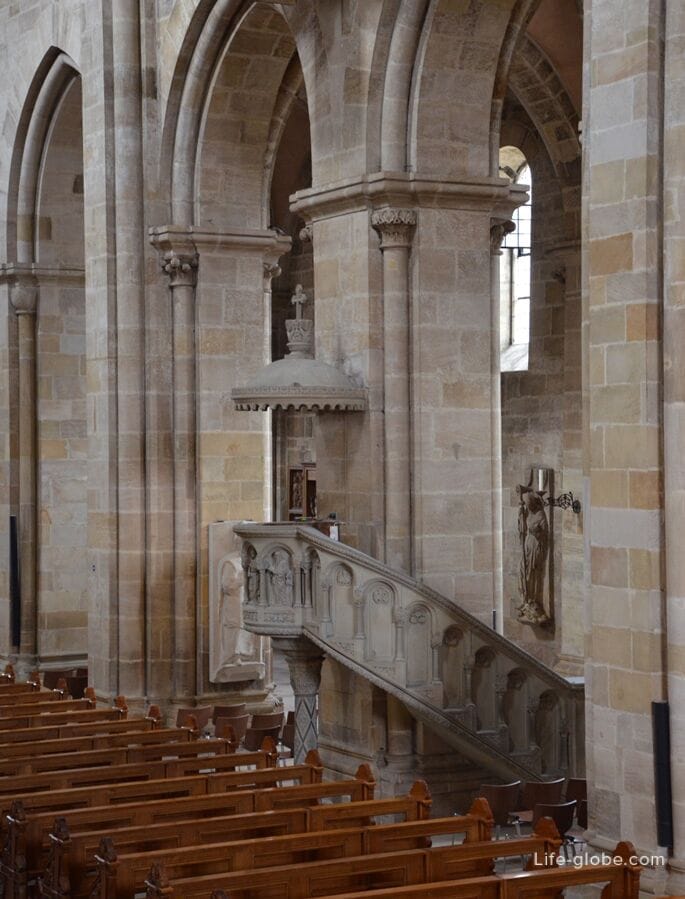
- organ. In 1415, the first organ appeared in the Bamberg Cathedral, and even then organ music was the hallmark of festive church services.
Today's organ was installed in 1976. About 40 concerts with the participation of the cathedral organ are held annually;
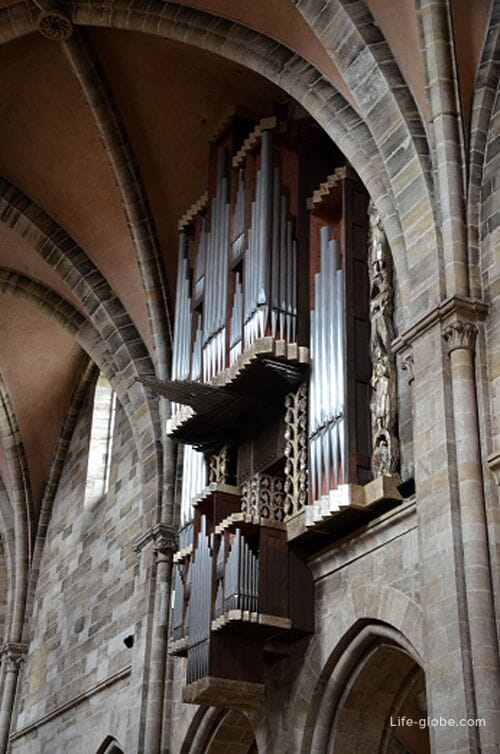
- The Kirchgattendorfer Altar, which depicts Mary with a halo, surrounded by St. Catherine of Alexandria with a sword and Barbara with a cup and a feather. The inner side of the side doors of the altar is decorated with scenes from the life of Mary and the childhood of Jesus: the Annunciation, the birth of Jesus, Mary and Elizabeth, Mary and the three holy Magi. At the base of the triptych is the death of Mary.
The Kirchgattendorfer altar is no longer used for worship. This altar comes from the 16th century, from the evangelical parish church of Kirchgattendorf at Hof, since 1921 it has been installed in the cathedral;

- Riemenschneider altar (Riemenschneider-Altar), assembled in 1926 from various sculptures. There is no altar table in it;
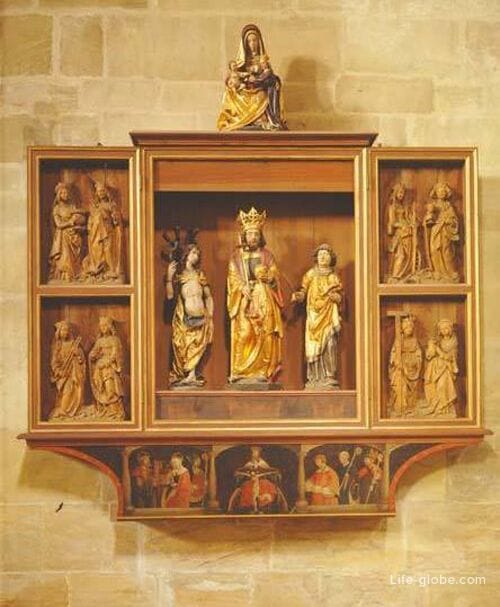
- The Chapel of the Holy Communion (Sakramentskapelle) is a small chapel in the side aisle, which got its name during the liturgical reconstruction in 1904.
The unquenchable lamp above the portal indicates that there is a casket in the chapel in which the sacred prosvirs are kept. The rosary painting is attributed to Lucas Cranach (1520);
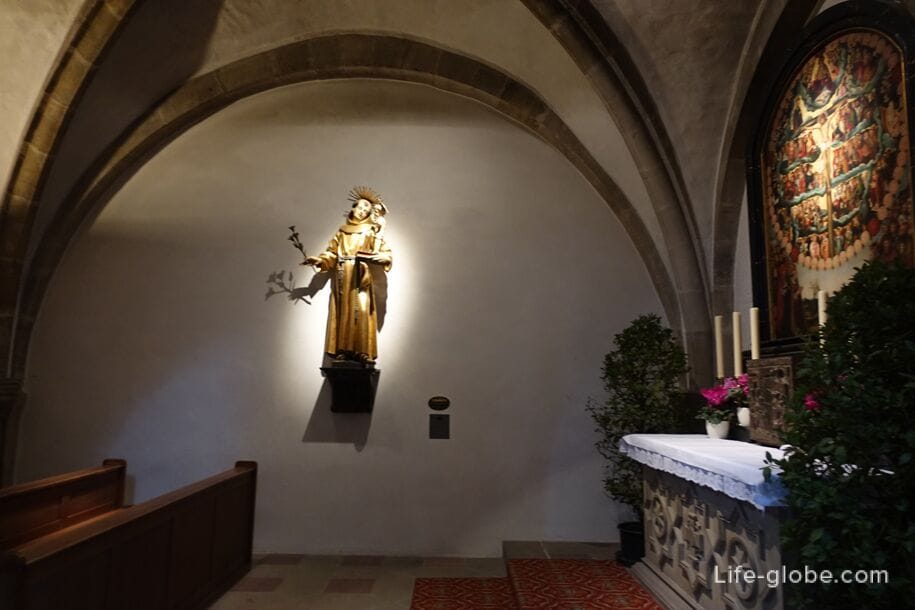
- paintings of the Way of the Cross, created by Felix Baumhauer (1922). Painted under the impression of the 1st World War, they are both a monument to the victims and their suffering;
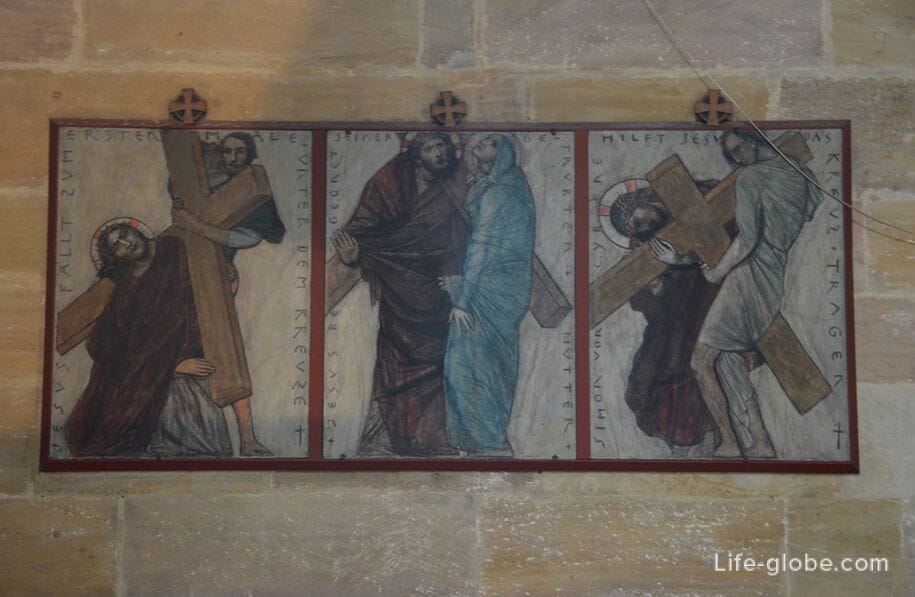
- frescoes, epitaphs and sculptures, the most famous of which isThe Bamberg Horseman (Bamberger Reiter) is the oldest surviving realistic medieval equestrian sculptures made of stone, as well as the most significant and famous work of art adorning the Bamberg Cathedral.
The Horseman was created around 1235 by an unknown master. It is also unknown who the sculpture depicts. There is a version that the crown indicates the king, and the canopy indicates the saint, so the figure represents Stephen of Hungary, the canonized first Christian Hungarian king, who, according to legend, was baptized in Bamberg Cathedral. It was also assumed that this was Conrad III, Constantine the Great, one of the three Magi kings, or simply a symbolic embodiment of a medieval knight.
The sculpture is placed on the northern column at the entrance to the eastern choir.
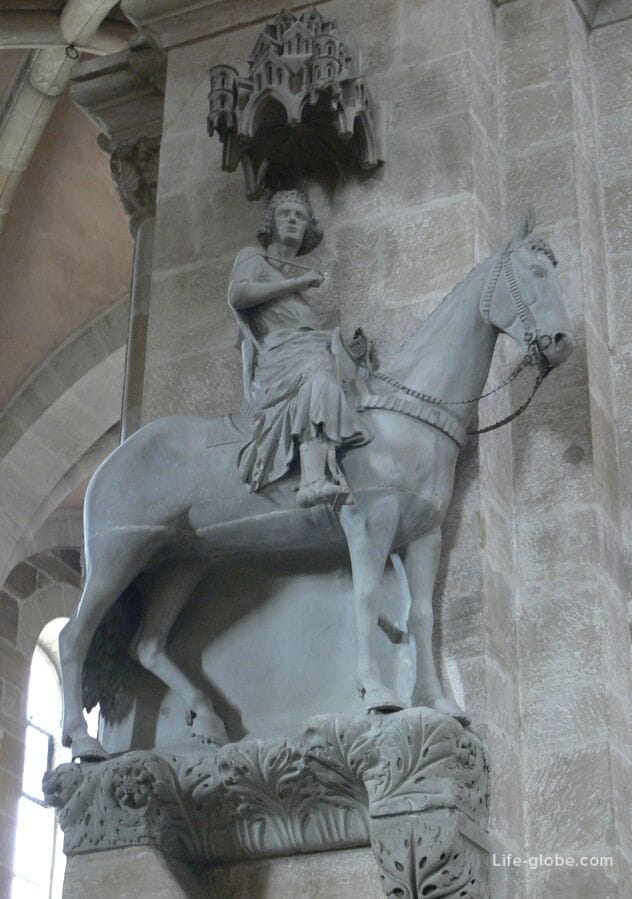
In the transept of the cathedral there are:
- the altar of Maria Veit-Stoß (Veit-Stoß-Altar), 1520-1523.
In the center is the birth of Jesus, on the left is the flight of Mary and Joseph with the baby to Egypt and below is the adoration of the Magi to the Baby, on the right is the birth of Mary, below it is the presentation of Jesus to the Temple.
This altar was formerly the main altar of the Carmelite Church in Nuremberg. The son of the Nuremberg woodcarver Veit Stoss and Andres Stoss, who later became the abbot of the Carmelite monastery in Bamberg, moved the altar, which was part of a large ensemble, from Protestant Nuremberg to Bamberg around 1530.
The box and sashes are made of spruce, carved sculptures made of linden. Initially, the altar was honey-colored, but as a result of conservation work of the 19th century, it darkened. The altar of Mary was given to the cathedral by the chapter of the Bamberg Church of Our Lady and since 1937 has occupied its place in the Bamberg Cathedral.
It is worth paying attention to the fact that already in the scene of the nativity of the altar there is an angel with a cross, indicating the coming suffering and death of Jesus on the cross;

- St. George's altar or the altar of George (Georgenaltar) of 1575, which has been preserved only fragmentally.
Many legends have been created about George. The most famous is his fight with the dragon.
Most of the altar scenes show various medieval scenes of torture, with which George was tortured to death.
Saint George was greatly revered by Emperor Henry II and even today is considered the patron saint of the cathedral and the city of Bamberg;
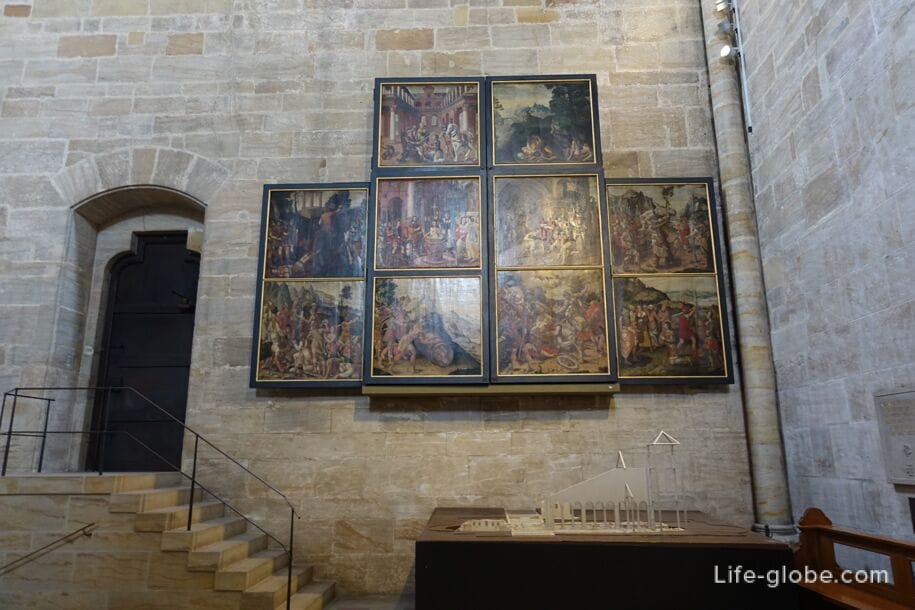
- Mühlhausener Altar (Mühlhausener Altar). Created around 1500, the altar of Mary comes from the evangelical parish church of Mulhausen at Pommersfelden. It was used there as a parish altar until 1781, when it was replaced by a new altar. In 1891, the altar was bought and presented to Archbishop von Schork, who donated it to the Bamberg Cathedral in 1904.
Mary is represented as the mother of the Lord, the heavenly queen and the lunar madonna. The side panels depict scenes from the life of Mary: on the left - the Annunciation and the image in the temple, on the right - the birth of Christ and the worship of the three holy Magi.
In May and October, the months of Mary, this figure of Mary from the Muhlhausner altar, decorated with flowers, is installed on the pylon of the altar room;

- Chapel of the Holy Nail (Nagelkapelle), designed for small worship and quiet prayer.
A relic - a nail from the Cross of the Lord has been kept in the chapel since the 14th century.
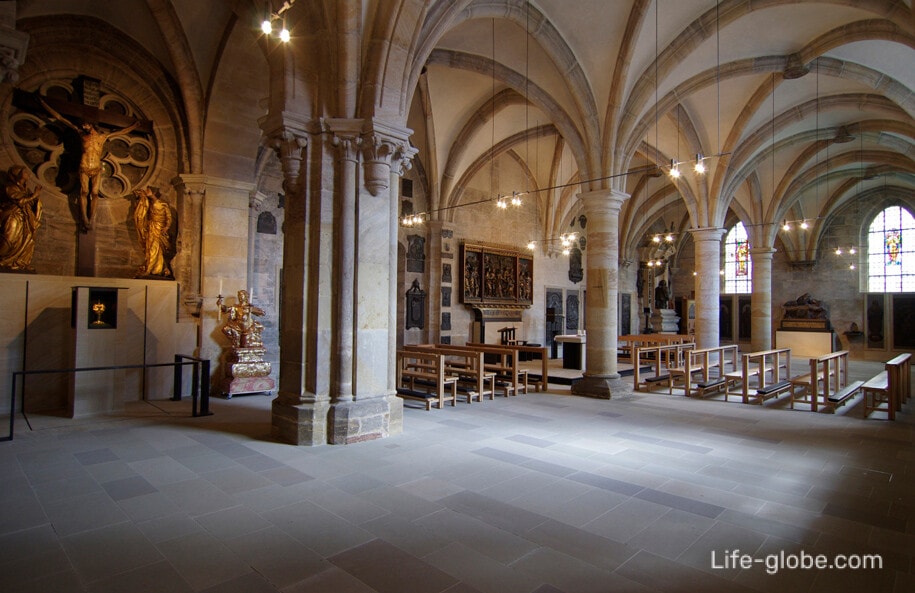
Cathedral Museum
In the neighboring chapter house, to the south (right) of the Bamberg Cathedral itself, today there is the Cathedral Museum (Diözesanmuseum Bamberg).
The chapter house of the cathedral was built by the master builder Balthazar Neumann between 1731 and 1733 in the Baroque style. The first plans of the museum were made back in 1907, but only in 1966 it opened under the auspices of the Metropolitan. The exhibition halls were opened in 1991 and 1992 and expanded in 2005.
The collection of the Museum of the Diocese of Bamberg focuses on treasures and architectural sculptures from Bamberg Cathedral, dating from the time of Henry II and his wife and up to the 21st century. The museum presents medieval vestments, Franconian sculptures of the late Gothic and Baroque eras, as well as objects of religious folk art. The most important exhibits in the museum include the cloak of Emperor Henry II, the cloak of Empress Cunegonde, the regalia of Pope Clement II and the so-called Gunther cloth, a silk fabric from Byzantium.
Museum website: dioezesanmuseum-bamberg.
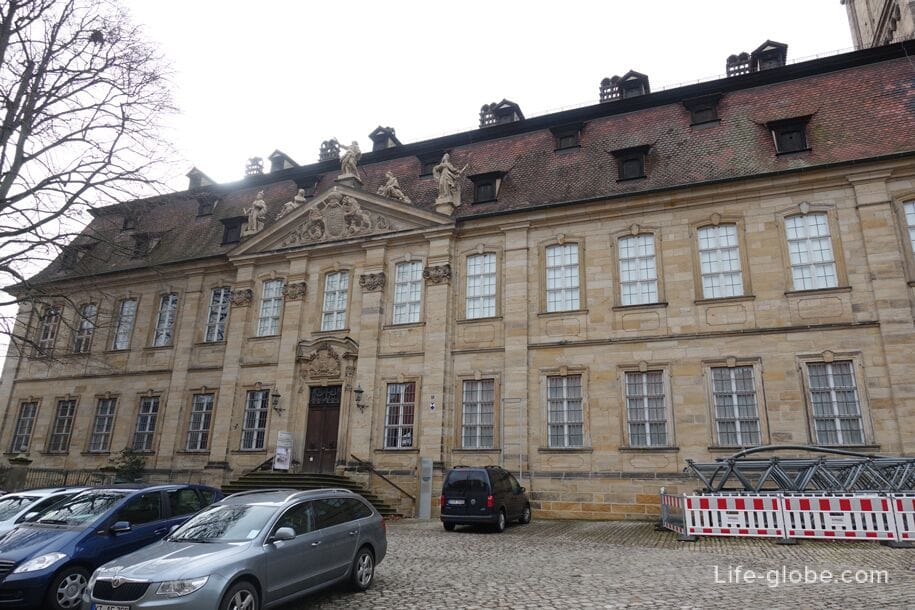
Practical information
Bamberg Cathedral is located in the historical center of Bamberg, on Cathedral Square (Domplatz), next to A new Residence (Neue Residenz) with a gallery, library and rose garden, as well as The old courtyard (Alte Hofhaltung) with half-timbered houses, a historical museum and a theater.
Coordinates of Bamberg Cathedral: 49°53'27.0"N 10°52'57.0"E (49.890833, 10.882500).
Entrance to the cathedral is free. Excursions are conducted in the cathedral.
Bamberg Cathedral website: bamberger-dom.
All accommodation facilities in Bamberg, including in the historical center of the city and more remotely from it, can be viewed and booked here




